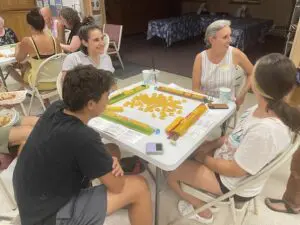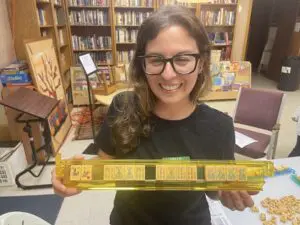A classic game thrives in the Highlands
Remember mahjong? That game where Jewish grandmothers push thick ivory tiles etched with exotic characters around a card table? They put down a tile and say something like “one bam,” “three crack” or “two dot.” There’s lots of schmoozing, maybe iced tea and onion dip. The big winner pockets two or three bucks.
The game, which dates to mid-19th century China, is undergoing a national renaissance, including in Philipstown and Beacon. Plenty of bubbies still play, but a new generation has discovered the joy of using tiles to form “hands,” similar to gin rummy.
“It’s not all luck, but it’s not as intensely cerebral as chess,” says Karen Sine, who lives in Beacon and plays at the Beacon Hebrew Alliance. “I like the sensory pleasure of it, the look and feel of the tiles, the colors, the shapes and the sound.”
The monthly event in the synagogue basement began early last year and draws as many as 16 people, enough for four games, including one for beginners. On a recent evening, one player brought fresh-baked mandel bread for noshing.

Sine, who is not Jewish, learned mahjong as an undergraduate at Catholic University in Washington, D.C. After working on theater productions, the crew would head to a Chinese restaurant. “There were these elderly Chinese men off to the side playing mahjong,” Sine recalls. “I didn’t know what it was, but you could hear the clicking of the tiles.”
She learned to play but only returned to the game recently after her daughter in Phoenix sent her a set she found at a thrift store. “As soon as I saw those tiles, I wanted to play again,” Sine says.
The BHA mahjong night was organized by Jessica Dommu of Beacon and Jenny Kaplan of Cold Spring, soon after they met at the synagogue and learned they both love the game. Kaplan grew up playing mahjong at family Passovers in Palm Springs, California. “It’s a bonding game,” she says.
The game is growing nationally, which Annelise Heinz, author of Mahjong: A Chinese Game and the Making of American Culture, attributes to retiring Baby Boomers. “Mahjong has always been a wonderful way to build community in a new place,” she says.

One of those retirees is Jack Weinstein, 76, a Philipstown resident who learned mahjong as a child at his grandparents’ bungalow resort in the Catskills. Weinstein, a former accountant, returned to the game in 2019.
During the pandemic, he was able to play online at RealMahJongg.com. “The site was a lifesaver,” said his wife, Linda Weinstein, 75, who began teaching the game last year at the Butterfield Library in Cold Spring. The retired bookkeeper began playing 25 years ago. She has taught a dozen people to play at the library.
One student is Ginette Voldman, who lives in Cold Spring and says she learned mahjong “for the social aspect, meeting new people.”
Heinz says movies like Crazy Rich Asians and The Joy Luck Club have helped popularize mahjong among young Asian Americans. Social media also plays a role; the Facebook group, Mah Jongg: That’s It, has doubled in size to nearly 90,000 members in three years.
Reporter’s Notebook: Winning My First Round
Heinz said the game’s association with Jewish culture began in 1937 when Jewish women in New York City sought to standardize the rules of what is now called “American Mahjong” and formed the National Mah Jongg League, which publishes a card with the winning “hands” for that year. Synagogues still sell the cards to raise money.
Synagogues such as the Beacon Hebrew Alliance are introducing the game to Gen Zers like Lucinda Arginsky, 12, of Beacon. “It’s just an engaging game,” she says. “I also like hanging out with other people.”

